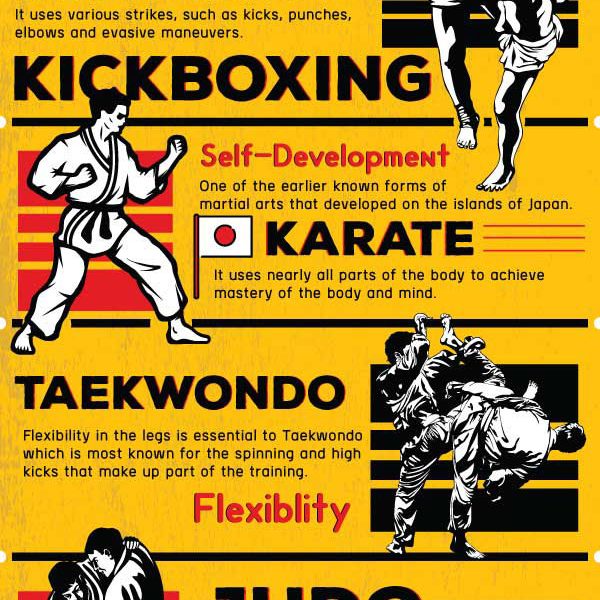The Background And Development Of Martial Arts: From Its Old Origins To The Techniques Practiced Today
The Background And Development Of Martial Arts: From Its Old Origins To The Techniques Practiced Today
Blog Article
Article By-Busk Ayers
Step into the globe of martial arts, where ancient origins and modern-day techniques collide in an exhilarating trip of self-control and self-discovery.
As you explore the history and development of this exciting art form, prepare to be mesmerized by the social influences, technical improvements, and extensive philosophy that have shaped it over centuries.
From the battlegrounds of old human beings to the training premises these days, martial arts have actually stood the test of time, constantly adjusting and growing.
Each strike, each activity, brings with it the weight of countless years of practice and wisdom, passed down through generations. This is a tale of resilience, of warriors that looked for not only physical prowess, yet also inner strength and consistency.
Join us on this remarkable exploration as we discover the keys, the tales, and the transformational power of martial arts.
Prepare to be influenced, challenged, and forever transformed by the background and development of martial arts.
Cultural Influences on Martial Arts
As you discover the history and advancement of martial arts, you'll swiftly find the remarkable ways in which cultural impacts have shaped these combat methods.
From the ancient worlds of China and India to the a lot more recent growths in Japan and Brazil, martial arts have been greatly affected by the societies in which they came from.
For example, Chinese martial arts, such as Martial Art and Tai Chi, are deeply rooted in the approach of Taoism and the principle of Yin and Yang.
In contrast, Japanese martial arts, like Martial arts and Judo, show the samurai warrior traditions and the values of self-control and honor.
In a similar way, Brazilian martial art, Capoeira, combines aspects of African dance and music, mirroring the cultural heritage of African servants in Brazil.
https://wjla.com/news/local/fairfax-education-kids-books-childrens-literature-focus-family-martial-arts-academy-three-ninja-pigs-jujitsu-karate-aikido-black-belt-library-reading-with-robert-washington-dc-virginia-maryland offer each martial art its distinct features however additionally offer a much deeper understanding of the historic and social contexts in which they progressed.
Technical Developments and Martial Arts
With the rise of sophisticated weaponry and ingenious training tools, you've had the ability to boost your skills and adjust to the ever-changing fight landscape.
Technical innovations have transformed the way martial arts are exercised and taught. Virtual reality simulations now allow you to learn reasonable combat circumstances without the danger of physical damage. High-speed video cameras capture every move, enabling you to analyze and ideal your techniques. Wearable gadgets monitor your heart rate, breathing, and muscle activation, providing instant comments on your efficiency.
Additionally, the advancement of specific equipment, such as resistance bands and dexterity ladders, has actually allowed you to enhance your speed, stamina, and agility. These technical developments have not only made training much more efficient but have actually also pressed the borders of what is feasible in martial arts, allowing you to get to new elevations in your practice.
The Approach and Principles of Martial Arts
The philosophy and principles of martial arts are deeply rooted fit your way of thinking and instilling self-control, emphasis, and regard in your technique.
1. Way of thinking: Martial Arts educates you to develop a strong and resilient way of thinking. It enables you to get rid of difficulties both on and off the floor covering, pushing your restrictions and persisting when faced with misfortune.
2. Discipline: Martial Arts needs discipline and self-control. Through routine training and adherence to stringent rules and strategies, you find out to regulate your impulses and develop a strong job principles.
3. Emphasis: Martial Arts requires extreme focus and focus. By educating your mind to be existing in the moment, you enhance your capacity to respond quickly and effectively throughout battle scenarios.
4. Regard: Martial Arts emphasizes respect for oneself, teachers, educating partners, and challengers. It instructs you to value the skills and experiences of others, promoting a feeling of friendship and gamesmanship.
Conclusion
Congratulations on finishing your trip through the fascinating globe of martial arts! Throughout this expedition, you have seen the abundant background and remarkable evolution of these battle methods.
From their ancient beginnings to the modern-day techniques we see today, martial arts have been shaped by social impacts.
The integration of modern technology has also played a considerable role in revolutionizing the means martial arts are instructed and practiced in today day.
Nonetheless, it is necessary to keep in mind that martial arts are greater than just physical battle. https://fernandowtlqh.blogitright.com/29976246/martial-arts-vs-other-sports-why-it-s-an-ideal-option-for-kids incorporate profound approaches and assisting concepts that surpass the plain act of fighting.
Take a minute to review this obsolete journey and value just how the tradition of martial arts continues to grow in the present, transcending time and limits.
